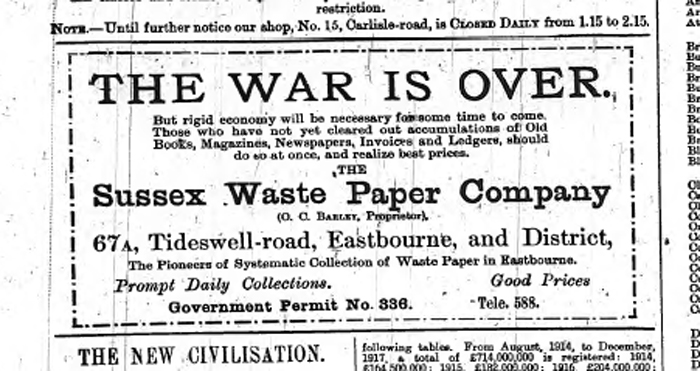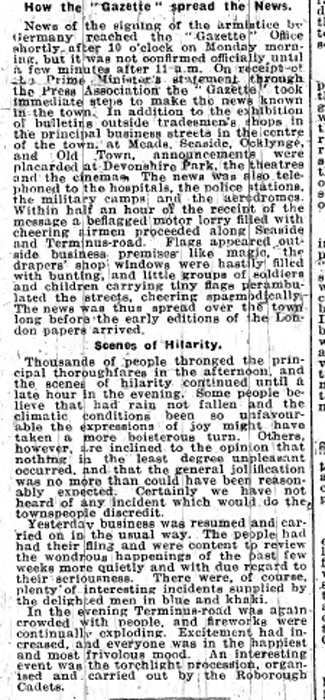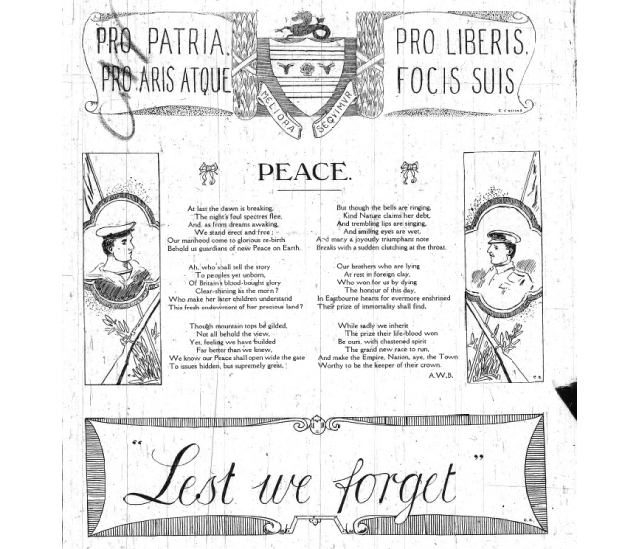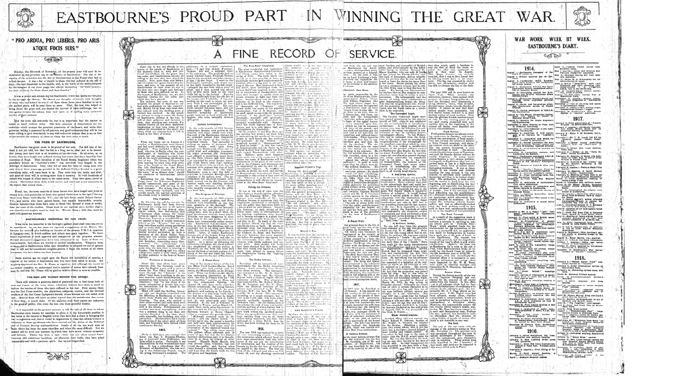When news of the Armistice reached Britain on 11 November 1918, newspapers in East Sussex reported on the joy and the solemn reflection of the county.
With the end of hostilities agreed early in the morning of 11 November 1918 and planned to take effect at 11am in France, the fighting was about to draw to a close. It was not a surprise when word of the end spread, it had become clear that the Germany Army had been defeated in the field and that an allied victory was imminent.
 Even so, rumour and hope could now give way to reality. However, whilst the Armistice signalled the end of the fighting it was not a guarantee that the war was over. It would not be until the Paris Peace Conference in 1919 that the war was brought to an end for Britain.
Even so, rumour and hope could now give way to reality. However, whilst the Armistice signalled the end of the fighting it was not a guarantee that the war was over. It would not be until the Paris Peace Conference in 1919 that the war was brought to an end for Britain.
Of the East Sussex newspapers the Eastbourne Chronicle, the Eastbourne Gazette, and the Hastings and St Leonards Observer none were published on the actual day of the Armistice announcement. This meant that, when several days later, editions began to appear in shops, the writers and editors had had time to consider the implications of the agreement and witness how it had been greeted within East Sussex.
Unlike with newspapers today, the front pages of some papers at the start of the 20th century were dedicated to advertisements, with actual stories appearing further inside. The first news of the Armistice in the Eastbourne Chronicle for 16th November, appears on page 2 where an advert for the ‘Sussex Waste Paper Company’ declares that, whilst the war is over, the ‘rigid economy will be necessary for some time to come’ and requests people still send in their old books and paper. Below this advert is an article which describes the Rev Jas Marchant’s recent lecture on ‘A New Civilisation’ as a ‘a happy coincidence of a wonderful week’.
News of how Eastbourne celebrated the news is to be found on page 6 where, upon receiving a ‘direct and special message’ the newly elected Mayor ordered the church bells to be run to spread the news before he addressed the crowd:
 Ladies and Gentlemen – We have very good authority for saying that the armistice is signed (loud cheers). It was probably signed early this morning, and that means a suspension of hostilities at once, to be soon followed we trust by a definite declaration of assured peace (cheers). There are one or two things I should like to say. First of all let me say that at eight o’clock this evening every place of worship, we trust, will have a service, and everyone who feels so inclined – and I anticipate all will – will, we hope, go there for the thanksgiving on this historic occasion (hear, hear). I don’t wish you to go to any special church, but go to your own place of worship. I beg also to appeal to you – and I hope you will do your level best to persuade everybody you can influence – to celebrate this great triumph with the greatest sobriety. We have gone through our troubles in a most magnificent manner in this country, and now that we have gained this great victory do not let it be said that we do not know how to celebrate it in a proper manner, worthy of every citizen in this country. Don’t let us lose our heads. Be happy, by all means – we have every reason for that; but let our enthusiasm be tempered with sobriety and good sense. Now please go and let it be known everywhere that this armistice has been duly signed (loud cheers).
Ladies and Gentlemen – We have very good authority for saying that the armistice is signed (loud cheers). It was probably signed early this morning, and that means a suspension of hostilities at once, to be soon followed we trust by a definite declaration of assured peace (cheers). There are one or two things I should like to say. First of all let me say that at eight o’clock this evening every place of worship, we trust, will have a service, and everyone who feels so inclined – and I anticipate all will – will, we hope, go there for the thanksgiving on this historic occasion (hear, hear). I don’t wish you to go to any special church, but go to your own place of worship. I beg also to appeal to you – and I hope you will do your level best to persuade everybody you can influence – to celebrate this great triumph with the greatest sobriety. We have gone through our troubles in a most magnificent manner in this country, and now that we have gained this great victory do not let it be said that we do not know how to celebrate it in a proper manner, worthy of every citizen in this country. Don’t let us lose our heads. Be happy, by all means – we have every reason for that; but let our enthusiasm be tempered with sobriety and good sense. Now please go and let it be known everywhere that this armistice has been duly signed (loud cheers).
The signing of the Armistice made the front page of the Eastbourne Gazette on 13th November, with an explanation of how the newspaper had spread word of the event on the 11th and the parties and fireworks that had gripped Terminus Road throughout the evening. In addition to this the edition of the paper for 20th November was devoted to the end of the war. The entire front page was handed over to the news of peace and a poem reflecting the sentiment.
 Within the newspaper, articles appeared celebrating the news that Germany was repatriating allied prisoners of war, so these men would shortly be returning home. Additionally early discussions of a War Memorial for the town were underway, whilst the work of women in Eastbourne was also celebrated. Also, news of the deaths of soldiers and those in military service continued to be reported and gave a sombre tone to the festivities.
Within the newspaper, articles appeared celebrating the news that Germany was repatriating allied prisoners of war, so these men would shortly be returning home. Additionally early discussions of a War Memorial for the town were underway, whilst the work of women in Eastbourne was also celebrated. Also, news of the deaths of soldiers and those in military service continued to be reported and gave a sombre tone to the festivities.
A final two page spread within the paper were given over to celebrating the role that Eastbourne had played in supporting the country throughout the two years of warfare.
By contrast, the Hastings and St Leonards Observer was fairly restrained in their coverage. The Armistice was not mentioned until page 6 of their 16th November edition, in an article outlining how the town had greeted the news. A lack of coverage of an event of this kind may seem unusual, but it also needs to be understood on several levels. Firstly, the paper came out almost a week after the armistice and, whilst clearly it was still news, they were no longer in a position to be informing people of something they were unaware of.
Also local newspapers often had to balance their focus between local interests and national significance. At the outbreak of war in August 1914, the Hastings and St Leonards Pictorial Advertiser dedicated more coverage to the ongoing sandcastle competition than they did to news of war.
Despite this, the coverage of the Armistice in local newspapers showed the people of East Sussex to be hugely relieved and jubilant at the end of the war and the fighting. Finally, after four years of conflict, peace had returned. However, there were also clear fears over what the coming months would hold, whether the peace could be maintained, and concern for the lives and wellbeing of those men still in France and those families whose loved ones would not return home.









